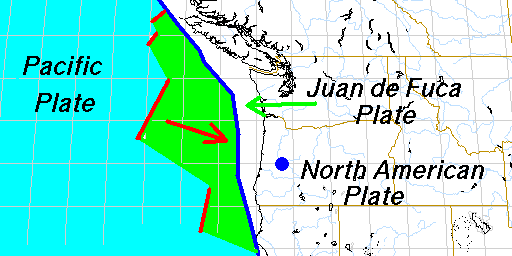Question: What is electromagnetic radiation?
-
Electromagnetic (EM) radiation is a form of energy, i.e., it has the
ability to perform work. Fine but let's be a little more physical.
Consider a simple analogy.
Suppose that we lived in the time before radio and television and an earthquake occurs off the coast of Oregon (every 500 or so years the Pacific Northwest is struck by a massive earthquake, Magnitude 9, and tsunami driven by the motion of the Juan de Fuca plate:

The last such event took place in 1700.
Question: How would we know the earthquake occurred?
- If the earthquake was large enough, different kinds of waves would
be generated. For example, the ground could shake. Also
a tsunami could be generated which
would move toward us. We would be made aware of the existence of the
earthquake by the shaking and tsunamis which smash into Oregon.
In this scenario the ocean and crust were disturbed by the earthquake. The disturbance created waves which moved from the point of the disturbance to us. The waves carried the information that an earthquake occured ( Cascadia Subduction Zone, ocean waves during Great Touhoku earthquake).
Question: What does this have to do with EM radiation?
There are four ways in which things interact in the Universe (we say
that there are 4 known types of forces that exist in nature).
This is neat because if we can understand these four forces
then we can understand
everything that happens in the Universe! The four forces are the
gravitational force,
electromagnetic force, strong force , and weak force.
Let's consider electrical interactions.
Suppose there are two electrical charges sitting in the Universe.
For definiteness, let one charge be positive and the other be negative
so that the two charges attract each other.

The strength of the electrical attraction is
Attraction = KqQ/D2
where K is a constant.
For charges q and Q, the strength of the attraction is determined
by the sizes of q and Q, their electrical charges, and
by the distance between the two charges, D. Now, suppose I grab
charge Q and jiggle it
around. What happens?
The jiggling causes the distance (and therefore
attraction) between the two charges
to vary, i.e.,

But,
just as in the earthquake scenario, we can ask,
How does the charge q know that I am jiggling charge Q?
That is, how does charge q know that I am
altering the electrical attraction (field) by moving Q? What
happens is that by moving charge
Q around, I generate a disturbance which
launches a wave (in a manner
analogous to the seimic waves and tidal waves generated by
an offshore earthquake). This wave is known as an
electromagnetic wave.
The wave
tells the Universe I generated an electrical disturbance somewhere in the
Universe by jiggling a charge around.
The phenomenon of waves generated by jiggling charges
is what we call electromagnetic (EM)
radiation.
There are four ways in which things interact in the Universe (we say that there are 4 known types of forces that exist in nature). This is neat because if we can understand these four forces then we can understand everything that happens in the Universe! The four forces are the gravitational force, electromagnetic force, strong force , and weak force.
Let's consider electrical interactions. Suppose there are two electrical charges sitting in the Universe. For definiteness, let one charge be positive and the other be negative so that the two charges attract each other.

The strength of the electrical attraction is

But, just as in the earthquake scenario, we can ask,
That is, how does charge q know that I am altering the electrical attraction (field) by moving Q? What happens is that by moving charge Q around, I generate a disturbance which launches a wave (in a manner analogous to the seimic waves and tidal waves generated by an offshore earthquake). This wave is known as an electromagnetic wave. The wave tells the Universe I generated an electrical disturbance somewhere in the Universe by jiggling a charge around. The phenomenon of waves generated by jiggling charges is what we call electromagnetic (EM) radiation.
Question: What do we mean by electromagnetic spectrum?
In order to discuss electromagnetic radiation let me elaborate a bit on our analogy. Suppose I tap periodically a pan of water. In this way I set up a series of disturbances. This sets up a series of waves. From this set of waves (disturbances) I can define what I mean by waves and so can make a a few definitions to describe waves.


The faster I jiggle the charge (the faster I tap the water), the shorter the distance between the wave peaks, that is, the shorter is the wavelength of the wave. The wave pattern moves at the speed of light, c = 300,000 km per second, regardless of the speed of the jiggling. This combined with the increase or decrease in the wavelength induced by the speed of the jiggling says that the rate at which peaks pass by changes (the frequency of the wave changes). The mathematical relationship between wavelength, W and frequency, f is given by
The energy carried by the wave is given by
-
We arbitarily define the different types of electromagnetic radiation
by their wavelengths (frequencies).
In order of increasing frequency (decreasing wavelength):

Comment 2--Our discussion considered distortions to water by an object or event. Imagine the similar situation where two massive objects attract each other through the gravitational force. In this case, if one of the objects is jiggled, one expects that the attraction between the two masses will also change. Again, how the information of the jiggling mass is carried to the other mass, is through waves, the so-called gravitational waves . As do electromagnetic waves, gravitational waves travel at the speed of light c.
